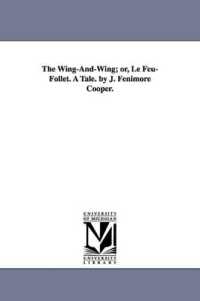- ホーム
- > 洋書
- > 英文書
- > Literary Criticism
Full Description
This book explores the intersection between medicine and literature in medieval Iberian literature and culture. Its overarching argument is that thirteenth- and fourteenth-century Iberian authors revalorized the interconnection between the body, the mind, and the soul in light of the evolving epistemology of medicine. Prior to the reintroduction of classical medical treatises through Arab authors into European cultures, mental disorders and bodily diseases were primarily attributed to moral corruption, demonic influence, and superstition. The introduction of novel regimens of health as well as treatises on melancholia into academic institutions and into the cultural landscape provided the tools for newly minted authors to understand that psychosomatic illnesses stemmed from malfunctions of the body's biochemical composition.
This book demonstrates that the earliest books written in the Iberian vernaculars contain the seeds that effect the shift from a theocentric worldview to a humanistic one. The volume features close readings of multiple texts, including medical treatises and religious writings, and King Alfonso X's Cantigas de Santa Maria, Juan Manuel's Conde Lucanor, and Juan Ruiz's Libro de buen amor. Even though these texts differ in literary genre, rhetorical strategy, and even purpose, this study argues that they collectively employ humoral pathology and melancholic discourses as a means of underscoring the frailty and transience of human life by showing how somatic conditions sicken the body, mind, and soul unto death.
Contents
Introduction: Melancholia and its Evolution in Thirteenth Century Iberia
Part I: Melancholia and Madness
1: "Mais braadou come cabron": Madness in Cantigas de Santa Maria
2: Melancholic Delusions in the Margins of El Conde Lucanor
Part II: Rabies or Hydrophobia
3: Rabid Melancholy in Cantigas de Santa Maria
4: Fear without Cause and Rabies in Juan Manuel's Exemplo 47
Part III: Lovesickness or Amor Hereos
5: Disturbances of the Body and the Soul: Love Melancholia in Cantigas de Santa Maria
6: "Mano en Mexilla": The Lovesick Poet in Libro de buen amor
Part IV: Acedia and Mystical Lovesickness
7: Diseases of the Soul in Cantigas de Santa Maria
8: Writing about Melancholia to Allay Acedia in Libro de buen amor
9: Mystical Lovesickness in Cantiga 188
Conclusion






